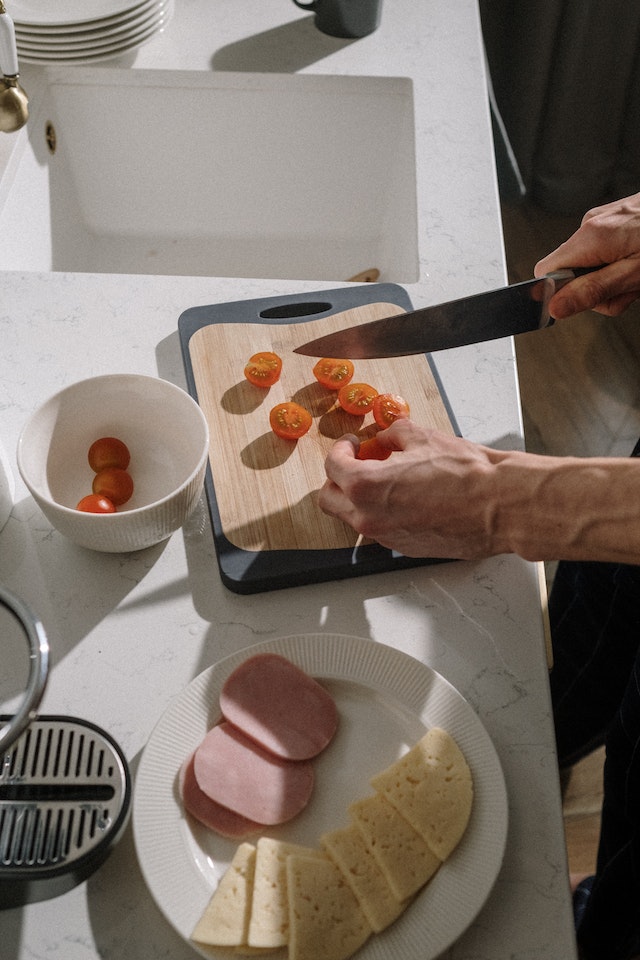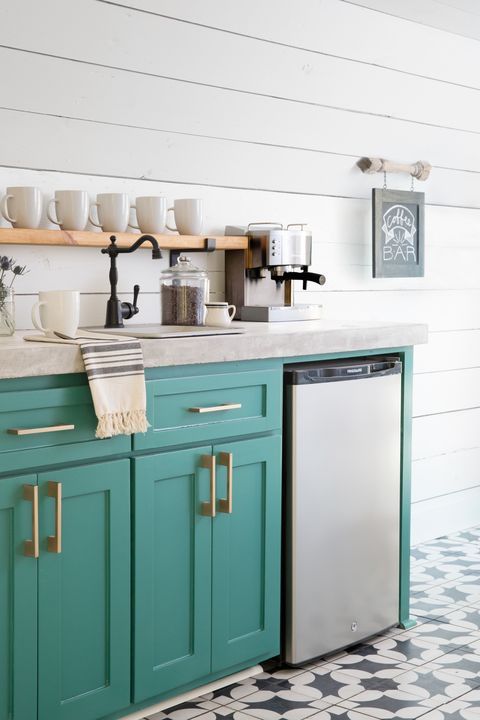The kitchen, often the hub of the home, is where meals are prepared and memories are created. Ensuring this space is both functional and beautiful is crucial.
Incorporating natural stone into your kitchen design can achieve this.
In this article, we will explore how natural stone elements, specifically stone kitchen benchtops, can elevate the aesthetic appeal and practicality of your kitchen.
Different Types of Natural Stone Tiles for your Kitchen
Before diving into the world of natural stone tiles, it’s essential to understand the variety available and how each type can contribute to your kitchen’s overall look and feel.
- Granite is a preferred material for kitchen flooring and countertops due to its durability and resistance to heat. The unusual speckled appearance of this material, which is available in a number of colors, enhances any kitchen design.
- Marble: Marble is what luxury looks like. Because of its veined patterns and delicate color variations, it may transform your kitchen island into a spectacular center point. However, marble requires a bit more maintenance because to its susceptibility to scratches and stains.
- Limestone: Limestone may be the best material for you if you desire a rustic or country-style kitchen. Its earthy tones and textured surface provide a cozy and welcoming ambiance in the space.
- The tough, non-porous stone known as quartzite is ideal for kitchen countertops because it can endure heat and scratching. The wide range of colors and designs it comes in offer flexible design possibilities.
- Slate: Due to its incredible strength and stain resistance, slate tiles are fantastic for kitchen flooring. Their naturally cleft surface provides an anti-slip property, adding an added layer of safety to your kitchen.
It’s important to select a stone that complements your lifestyle and kitchen usage because each type of stone has distinct qualities and upkeep requirements.

How to Mix and Match Natural Stone with Other Materials in Your Kitchen
If you’re planning a kitchen design, you don’t have to utilize natural stone exclusively, even if you’re working with a natural stone supplier.
In reality, natural stone can be combined with various other materials to create a dynamic, layered look.
This blend of materials can result in a design that is not only fashionable but also practical.
A natural stone supplier can provide you with a range of options to help you achieve this balanced and stylish aesthetic in your kitchen.
- Stone and Wood: This classic combination of stone and wood is always in trend. The contrast between the warm, natural feel of wood and the cold, hard surface of stone strikes a pleasant note. For instance, you may pair a stone wall background with a wooden dining table or a wooden kitchen island with stone countertops.
- For a more modern and industrial look, take into account fusing stone and metal. The reflective surface of metal, such as that seen on stainless steel fixtures or appliances, contrasts effectively with the matte finish of stone. For instance, a gorgeous focus point may be a stainless steel range hood adjacent to a stone backsplash.
- Stone and Glass: A glass backsplash or cabinets with glass fronts may add a touch of elegance to a stone kitchen. Glass’ transparency contrasts with stone’s hardness to visually make the space appear brighter and more spacious.
- Using ceramic tiles as a backsplash may make actual stone seem great next to them. It is possible to contrast the shiny surface of ceramic tiles with the rough texture of stone to provide depth and mystery to your kitchen design.
- Never underestimate the power of color, especially in stone and paint. A well-chosen paint color may accentuate the natural beauty of stone. For instance, a light gray wall color may highlight a marble countertop whereas a light granite countertop contrasts beautifully with a dark navy blue wall color.
When combining different types of materials, it’s important to keep the room’s overall harmony and balance in mind. It’s recommended to stay with two or three major materials and utilize others as accents since using too many different materials might make the kitchen appear cluttered.

Kitchen Inspiration Ideas: Tips & Tricks
Designing a kitchen with natural stone can indeed be an exciting endeavor.
Here are motivational thoughts and helpful hints to help you maximize the potential of this versatile material in your kitchen design.
Whether you’re considering granite, marble, or quartz, the natural beauty and durability of stone can enhance the aesthetic and functionality of your kitchen.
Here are some motivational thoughts and helpful hints to help you get the most of this flexible material.
- Highlight Stone with Light: Natural stone has a unique response to light. Darker stones may create a warm, personal environment, while lighter stones can make a place appear brighter. When selecting the stone for your kitchen, take into account the natural light. The depth and texture of darker stones, for example, can be advantageous in a kitchen with lots of natural light.
- Use texture to your advantage: Many different textures and sheens are possible with natural stone, from smooth and glossy to honed and matte to rough and rustic. It’s okay to combine materials without worry. A tumbling stone backsplash stands in striking contrast to a polished granite countertop.
- Combine different kinds of stone: No one ever declared that just one kind of stone may be used. Including many stone types may provide dimension and interest to your kitchen. You may go with marble for the island but granite for the rest of the counters.
- Using stone goes beyond countertops: Stone, with its natural elegance and durability, is a versatile material that can be used in various applications, making it a popular choice for many homeowners. Stone kitchen benchtops are particularly favored for their unique aesthetic and functional benefits. But the use of stone doesn’t have to stop there. Consider incorporating stone into your walls, floors, or even crafting a sink out of it. This can create a cohesive and distinctive aesthetic throughout your home, enhancing its overall appeal.
- Add a Pop of Color: Natural stone, despite its penchant for neutrality, may form a wonderful backdrop for splashes of color. Consider using colorful appliances, vibrant china, or eye-catching bar stools to add flair to your stone kitchen.
Remember that reflecting your individual wants and personality in your kitchen design is the key to success. Break the norms and design an environment that you enjoy without being frightened to do so.

How to Maintain and Care for Natural Stone Surfaces
Natural stone adds a timeless elegance to your kitchen, but it also has to be properly cared for to keep looking good.
Here are some pointers for maintaining the finest possible appearance for your stone kitchen countertops and other surfaces.
- Sealing: Because most natural stones are porous to some extent, spills and stains can penetrate them. As a natural stone provider, we suggest sealing your stone surfaces in order to protect them. In general, sealing should be carried out once a year, however this may vary based on the type of stone and usage.
- Cleaning: To clean on a daily basis, use warm water, a soft cloth, and a mild, pH-neutral cleaner. Avoid using harsh or abrasive cleaners since they might damage the stone’s surface. Always mop up spills as soon as they happen to prevent discoloration.
- Scratch Resistance: While many types of stone are scratch-resistant, they are not scratch-proof. Use cutting boards while preparing meals and avoid dragging heavy pots or appliances over your stone worktops.
- Natural stone can withstand heat, but it can also be harmed by sudden or extreme temperature changes. Trivets or heat cushions are advised for use below hot pots and pans.
- Repairing Damage: If your stone surface becomes damaged or fractured, don’t panic. Small issues may frequently be fixed by an expert. If you’re unsure, get advice from your natural stone provider.
Remember that maintaining natural stone requires routine upkeep and prompt response to spills and damages. With the right care, your stone kitchen countertops and other surfaces might last a lifetime.
Conclusion
“Stone kitchen benchtops” made from natural stone may be used to create a kitchen that is not only practical but also emits a special elegance and beauty.
There is a natural stone to fit every inclination and taste, whether you are drawn to the toughness of granite, the grandeur of marble, or the rustic charm of limestone. These stone kitchen benchtops can truly elevate the aesthetic appeal of your kitchen.
Remember that we are here to help you at every turn as a natural stone provider, from helping you choose a stone to offering advice on upkeep and care. To create a room that represents your individual style, don’t be afraid to blend various stone and material kinds in your kitchen design.
We hope that our advice has encouraged you to think about the elegance and adaptability of natural stone as you renovate or construct a new kitchen. Installing a stone floor or kitchen benchtop, for instance, is more than just a purely aesthetic decision for your house.
FAQs
What are the advantages of using natural stone in my kitchen?
Natural stone has numerous benefits such as durability, uniqueness, and a timeless aesthetic appeal. It also adds value to your home and is very easy to clean and maintain.
Which natural stone is best for kitchen countertops?
Granite, marble, and quartzite are among the top choices for kitchen countertops due to their hardness, heat resistance, and variety of patterns and colors.
How to maintain and clean natural stone kitchen surfaces?
To keep natural stone surfaces in the best condition, use a soft cloth or sponge with a mild detergent for daily cleaning. Avoid acidic or abrasive cleaners.
Is natural stone good for kitchen floors?
Natural stone is an excellent choice for kitchen floors as it is durable, long-lasting, and can withstand heavy traffic. Choices like granite, slate, and limestone are popular.
How much does it cost to install natural stone in the kitchen?
Costs can vary based on the type of stone, the size of the project, and the complexity of the installation. On average, homeowners might spend between $2,000 to $5,000.
Does natural stone increase the value of my home?
Yes, natural stone can significantly increase the resale value of your home due to its luxury appeal and long lifespan.
Can natural stone withstand heat and scratches in the kitchen?
Yes, most natural stones such as granite and quartzite are heat resistant and scratch-resistant, making them suitable for a busy kitchen environment.






